Interesting. There seems to be some merit in applying that reasoning to the Kurdish jambiya. I'm not sure the thumb along the side part would work well with the Kurdish jamb, just because the actual grip portion tends to be narrower than the parts that form the 'I' if I remember correctly. Now I kind of want a traditional style Kurdish jamb for a little learning and experimentation. I used to like the blade and not the handle, but now I want to get to know one better.
You are using an out of date browser. It may not display this or other websites correctly.
You should upgrade or use an alternative browser.
You should upgrade or use an alternative browser.
What makes a fighting knife
- Thread starter Scara
- Start date
- Joined
- Aug 17, 2003
- Messages
- 3,407

bigger version of mine. the blade is razor sharp on both edges, so you can use it upside down. the grip is comfortable in a hammer grip, a bit less so in a sabre grip, but do-able, tho the point is a bit off line. better upside down for the thrust. the whole knife is better for slashing or hooking. again mine is wootz with a humble but functional wood grip. many of not most older kurdish jambiah are wootz, the watered steel of legend only approximated by pattern welded steel mistakenly called 'damascus'.
another jambiah of mine from yemen
i'm not as fond of this one, especially not fond of the fancy silver scabbards most come with. this one has a plain leather scabbard, sewn to it's waist belt (which doesn't fit me)
the design to me sacrifices function for form.

Last edited:
Purdy. I wonder, you wouldn't happen to know if there's a typical length for the handle? I have large hands, and I have to wonder if maybe the handle on the one I tried was just a little too small for me. The one I tried, I had to kind of squeeze my fist into it, not just hold it in my fist.
- Joined
- Aug 17, 2003
- Messages
- 3,407
the kurdish ones are quite consistent in size from my experience. the scabbard on mine fits perfectly. it came from a friend on another forum who had a spare, so was unlikely to have been made for mine.
anyway, the grip is 14.5 cm. long, the 'guard' portion is 3 cm. long. the 'pommel part is 3.3 cm. the central portion is 8.2 cm. long x 2.5 cm. across. the guard/pommel sections are 5 cm. across, it's about 2.3 cm. thick thruout. the blade is 22.2 cm. in a straight line from the centre of the grip/blade junction to the tip.
how my 4 fingers just fit:

hammer grip: thumb along 'guard' indexes the edge nicely.

sabre grip:

you can also 'palm' the pommel, thumb on the spine of the grip recess.
another middle eastern double edged dagger, a shibariya. (jordan/palestine) this one was described as an assassin's dagger.
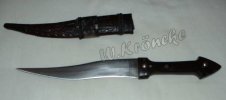
another shibariyah. not so fond of these versions, blade too wide in the wide bit and narrows too much towards the tip, also too durn fancy.
syrian jambiyah/shibriyah also way too showy for me.
![ph-0[1].jpg ph-0[1].jpg](https://www.bladeforums.com/data/attachments/307/307097-fb1428ad2397b127559e8cea364fe061.jpg)
anyway, the grip is 14.5 cm. long, the 'guard' portion is 3 cm. long. the 'pommel part is 3.3 cm. the central portion is 8.2 cm. long x 2.5 cm. across. the guard/pommel sections are 5 cm. across, it's about 2.3 cm. thick thruout. the blade is 22.2 cm. in a straight line from the centre of the grip/blade junction to the tip.
how my 4 fingers just fit:

hammer grip: thumb along 'guard' indexes the edge nicely.

sabre grip:

you can also 'palm' the pommel, thumb on the spine of the grip recess.
another middle eastern double edged dagger, a shibariya. (jordan/palestine) this one was described as an assassin's dagger.

another shibariyah. not so fond of these versions, blade too wide in the wide bit and narrows too much towards the tip, also too durn fancy.
syrian jambiyah/shibriyah also way too showy for me.
![ph-0[1].jpg ph-0[1].jpg](https://www.bladeforums.com/data/attachments/307/307097-fb1428ad2397b127559e8cea364fe061.jpg)
Last edited:
- Joined
- Aug 17, 2003
- Messages
- 3,407
sometimes the best knife is an axe.
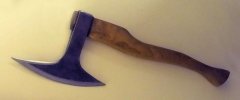
war axe, a nice stabby one that lives on my wall
next to my hanshees.
or a breeching axe:
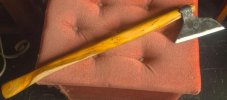
custom, had smith make me an unpolished
version of one he made for a US Marine
about to visit the talibunnies. this one has a yew haft,
the marine one had an ash one.
a boarding axe in D2 will do as a breecher too.
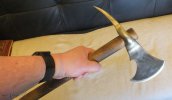

war axe, a nice stabby one that lives on my wall
next to my hanshees.
or a breeching axe:

custom, had smith make me an unpolished
version of one he made for a US Marine
about to visit the talibunnies. this one has a yew haft,
the marine one had an ash one.
a boarding axe in D2 will do as a breecher too.

Last edited:
One thing for sure on this site....you folk have a veritable museum of blades/tools from the near and far east....closest i ever came to such exposure was as a kid and an old merchant marine engineer lived next door and gave voyage slide shows to everyone and had a collection of of everything worthy of a bazaar....and made sure everyone in neighborhood obtained anything desired, we still have at mom's house 50 yrs later the coffee table from India with ivory inlay and the camel saddle...and kitchen knives from Japan when that was a novelty....but this place is great for info on exotic blades....thank you...i was trained to work with something more along the lines of a Randall #1 or #2 or #14 or #18....you pretty much were a newbie until you had one in some units....
And as mentioned previous, the khukuri makes a good battle axe but more versatile...which is where it shines....it does many things as well as more specialized tools....
And as mentioned previous, the khukuri makes a good battle axe but more versatile...which is where it shines....it does many things as well as more specialized tools....
D2 is not a very popular steel for anything that is supposed to take the stress of chopping; that being said, an axe has a different geometry etc. from a big knife, therefore I find this intriguing - especially since the steel has so many great qualities, like edge retention and rust resistance. Was this your choice expressly, for some reason, if I may ask? I suppose that at hardness below 60 it would offer a nice trade-off between D2's qualities and its limitations.
- Joined
- Mar 26, 2009
- Messages
- 2,228
What I carried was a Jambiya derivative I made rifht before I left:the kurdish ones are quite consistent in size from my experience. the scabbard on mine fits perfectly. it came from a friend on another forum who had a spare, so was unlikely to have been made for mine.
anyway, the grip is 14.5 cm. long, the 'guard' portion is 3 cm. long. the 'pommel part is 3.3 cm. the central portion is 8.2 cm. long x 2.5 cm. across. the guard/pommel sections are 5 cm. across, it's about 2.3 cm. thick thruout. the blade is 22.2 cm. in a straight line from the centre of the grip/blade junction to the tip.
how my 4 fingers just fit:

hammer grip: thumb along 'guard' indexes the edge nicely.

sabre grip:

you can also 'palm' the pommel, thumb on the spine of the grip recess.
another middle eastern double edged dagger, a shibariya. (jordan/palestine) this one was described as an assassin's dagger.
View attachment 548887
another shibariyah. not so fond of these versions, blade too wide in the wide bit and narrows too much towards the tip, also too durn fancy.
syrian jambiyah/shibriyah also way too showy for me.
View attachment 548888

Which once again points out the difference between "fighting knife", "dueling knife" and "combat knife"...this thing only came out of the sheath to make sure it would still come out, and would have been a poor choice for dueling-but perfect for an antipersonnel scraper.
An interesting side note-the woman who ran the program I workedfor had grown up in the middle east-Iran pre revolution, Oman, and other places-and when she saw me doing some silat drills with this thing she said what I was doing and what she'd seen two Omani dudes doing (in a for keeps fight on the street) were very similar-reverse grip, very circular cuts, thrusts and hooking traps-with much use of the inboard edge. I didn't ask her who won
I bought a shibariya in Amman for about $20 US-thin, very stiff spring steel, very flashy sheet metal work...but mess with it in reverse grip, convex curve outboard in close and the steep width transition makes a lot more sense. That belly really bites on a punch cut, and the concave edge traps pretty well (many cardboard shipping tubes from NJ Steel Baron died learning this lol)
Last edited:
- Joined
- Aug 17, 2003
- Messages
- 3,407
D2 is not a very popular steel for anything that is supposed to take the stress of chopping; that being said, an axe has a different geometry etc. from a big knife, therefore I find this intriguing - especially since the steel has so many great qualities, like edge retention and rust resistance. Was this your choice expressly, for some reason, if I may ask? I suppose that at hardness below 60 it would offer a nice trade-off between D2's qualities and its limitations.
oops, confused it with a different weapon or had a brain fart. i plead senility. my brain has too little room to store accumulated centuries of stuff. one of the perils of having more than a few sharp pointies. i do have a couple of traditionalfilipinoweapons swords/barong which are made from "5160/D2 blended steel, nitrate treated and tempered to 58~60 rc". i assume by 'blended' he means the steel specs rather than melting two together in a grass hut forge.
checked my records on the axe in question:
Hand forged from one solid piece of 4140 tool steel, after forging the ax head was normalized several times, including an overnight soak in vermiculite. Then the blade and spike were given a fiery edge and point quench, followed by triple temper cycles, producing a very tough and resilient weapon.The haft is hand cut, carved and sanded hardwood, that has been shaped with a gradual taper. This allows the head to be removed if necessary. The haft has hot formed grip stippling, and is finished with tightly wrapped natural brown leather. The handle has been lightly scorched and oiled.
Haft length 22 inches
head length 9,1/2 inches
blade length 4,1/2 inches
spike length 3,1/2 inches
edge/point hardness 60rc
Last edited:
D2 is not particularly rust resistant except when compared to plain high carbon steels....Dozier makes some large choppers from D2 but he also does the most sophisticated and careful heat treat out there to where he is known as Dr D2....the problem as with any high chromium steel, clumping in the grain boundaries....microscopic photos versus such as super clean Uddeholm steel tell it all...
- Joined
- Aug 17, 2003
- Messages
- 3,407
D2 is not particularly rust resistant except when compared to plain high carbon steels....Dozier makes some large choppers from D2 but he also does the most sophisticated and careful heat treat out there to where he is known as Dr D2....the problem as with any high chromium steel, clumping in the grain boundaries....microscopic photos versus such as super clean Uddeholm steel tell it all...
Bohler-Uddeholm (UK) Ltd are just 65 mi. north of me, about an hour on the motorway. they specialise in high purity alloy steels
oops, confused it with a different weapon or had a brain fart. i plead senility. my brain has too little room to store accumulated centuries of stuff. one of the perils of having more than a few sharp pointies. i do have a couple of traditionalfilipinoweapons swords/barong which are made from "5160/D2 blended steel, nitrate treated and tempered to 58~60 rc". i assume by 'blended' he means the steel specs rather than melting two together in a grass hut forge.
checked my records on the axe in question:
Hand forged from one solid piece of 4140 tool steel, after forging the ax head was normalized several times, including an overnight soak in vermiculite. Then the blade and spike were given a fiery edge and point quench, followed by triple temper cycles, producing a very tough and resilient weapon.The haft is hand cut, carved and sanded hardwood, that has been shaped with a gradual taper. This allows the head to be removed if necessary. The haft has hot formed grip stippling, and is finished with tightly wrapped natural brown leather. The handle has been lightly scorched and oiled.
Haft length 22 inches
head length 9,1/2 inches
blade length 4,1/2 inches
spike length 3,1/2 inches
edge/point hardness 60rc
Ok, thanks, that makes sense
As for the blended stuff, I stay intrigued, for a while I thought the edge is D2 the rest 5160, but more recently I thought they had some big scary dude actually melting both steels and mixing them with some huge paddle
Last edited:
D2 is not particularly rust resistant except when compared to plain high carbon steels....Dozier makes some large choppers from D2 but he also does the most sophisticated and careful heat treat out there to where he is known as Dr D2....
I think I've heard this mentioned before and that's pretty much it for serious choppers in D2.
When talking about rust resistance, you are right, my point of reference was plain carbon steel.
- Joined
- Aug 17, 2003
- Messages
- 3,407
...An interesting side note-the woman who ran the program I workedfor had grown up in the middle east-Iran pre revolution, Oman, and other places-and when she saw me doing some silat drills with this thing she said what I was doing and what she'd seen two Omani dudes doing (in a for keeps fight on the street) were very similar-reverse grip, very circular cuts, thrusts and hooking traps-with much use of the inboard edge. I didn't ask her who won
I bought a shibariya in Amman for about $20 US-thin, very stiff spring steel, very flashy sheet metal work...but mess with it in reverse grip, convex curve outboard in close and the steep width transition makes a lot more sense. That belly really bites on a punch cut, and the concave edge traps pretty well (many cardboard shipping tubes from NJ Steel Baron died learning this lol)
the way i've seen saudi/yemeni arabs carrying jambiyah in their belts is almost vertical centered on their belly with the point to the right side. this lends itself more to a reverse grip & push/hooking cuts. the saudi wahabbi mountain arabs carry a jambiyah more like short sword in length where that is impractical & carry them more like a sword, they do seem to hold them concave edge forward tho, like a khukuri. the kurds carry theirs in their sash more angled with the point and inner curve facing down, leading me to think they may use the inner edge more than the outer. the moroccan koummiyah is carried on a baldric, the main edge is inside the curve with a much shorter edge sharpening on the outer curve.
never saw a fight with them, but they'd all make decent kerambits.
interesting photos

yemenis
wahabbi arabs (from yemen) saudi ones are similar. the tribes and borders are a bit uncertain.
Last edited:
Regarding steels and grain and carbides, large carbides in such as 440C and D2 on the edge lead to good cutting power, tough sharpening, and as with flaws in a diamond or knots in a plank, introduce weakness against stress.
Versus super clean steels from such as Sandvik and Bohler-Uddeholm, near identical alloys but far tougher....even the Uddeholm version of 1095 is taken to levels unimaginable in the USA, and in knives such as the $11 Morakniv product...
Pictures are worth 1000 words and great link if allowed...otherwise i will begin copying and posting but it will be a while...
http://www.smt.sandvik.com/en/produ...l-knowledge/important-factors/microstructure/
Best photos i know of and settle many many a discussion...their site does not mention most steels by brand name but easy to figure out...and one can see how much is high dollar hype...
Versus super clean steels from such as Sandvik and Bohler-Uddeholm, near identical alloys but far tougher....even the Uddeholm version of 1095 is taken to levels unimaginable in the USA, and in knives such as the $11 Morakniv product...
Pictures are worth 1000 words and great link if allowed...otherwise i will begin copying and posting but it will be a while...
http://www.smt.sandvik.com/en/produ...l-knowledge/important-factors/microstructure/
Best photos i know of and settle many many a discussion...their site does not mention most steels by brand name but easy to figure out...and one can see how much is high dollar hype...

wahabbi arabs (from yemen) saudi ones are similar. the tribes and borders are a bit uncertain.
Sica, anyone?





Last one is a full-tang
And a modern reproduction:



If it was bigger, for two-hands wielding, it was a "falx".
I'd like to have one, someday.
Last edited:
- Joined
- Jun 24, 2013
- Messages
- 4,162
OK guys you did it.
I got this guest from JW Bensinger here at my house for a while now.
I didn't want to show it until I finish a review but can't hold it back anymore.
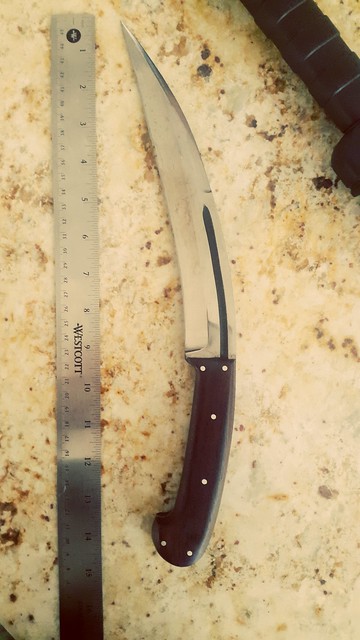
Hands down my best fighter but why and more details later

I got this guest from JW Bensinger here at my house for a while now.
I didn't want to show it until I finish a review but can't hold it back anymore.

Hands down my best fighter but why and more details later
Man that is fifteen inches of beauty right there! Is that the Fairbane(sp?) Kobra sikes...something like that? I say Yikes! I fell in love with the one he made a while back. That is awesome Jens:thumbup:
That there is a Fairbairn Cobra, yes. Now I have to resist the urge to drive to CA and steal it from Jens. I've had my eye on JW's Fairbairn Cobra before, especially after seeing the comments my mentor has made about the Cobra. JW is one of only two makers that I have seen that make them, and the other is expensive to ship from because they're over in Scotland.
